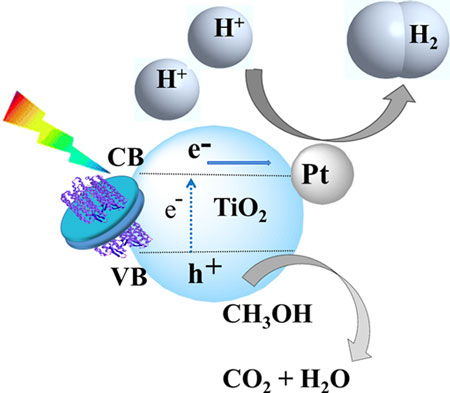| Posted: Jun 17, 2017 | |
Synthetic nano-bio architecture for nanocatalytic photon-to-hydrogen conversion(Nanowerk News) An international research team reports the deployment of a synthetic biology cell-free expression chassis for the design and assembly of an entirely man-made energy transformation nano-bio hybrid assembly. |
|
| Similarly to a natural light-driven proton pump bacteriorhodopsin (bR) from H. salinarium, the pump bRsyn in artificial purple membranes was integrated with TiO2 semiconductor nanoparticles, yielding a catalytic assembly for photon-to-hydrogen conversion. | |
 |
|
| Depiction of the photocatalytic cycle over the entirely synthetic Pt/TiO2-bRsyn hybrid nano-bio catalyst. (© ACS) | |
| With the advent of modern life science technologies, or 'synthetic life', it became achievable to design and produce key functional components of life, including chemically synthesized DNA circuits, proteins, and artificial cell membranes from scratch. | |
| For example, a living bacteria can be reprogrammed via transplantation of a chemically synthesized genome for rebooting cells with new desired functions such as biosyntheses of fine chemicals, protein therapeutics, or renewable biofuels. | |
| On the other hand it also became achievable to accomplish one of the core cellular functions, protein biosynthesis, outside of a living cell confined space, or cell-f ree, through the assembly of key logic elements of a cell, namely, an artificial biomembrane as a template, synthetic DNA as a blueprint, and an isolated biological translation machinery of a ribosome along with a supply of energy-rich chemicals, amino acids, cofactors, and enzymes. | |
| While emerging nanotechnology is getting inspiration from biological principles such as noncovalent dynamic interactions and cooperation of multiple dynamic processes and based upon modern powerful synthetic and fabrication approaches, it ultimately aims toward creation of new artificial heteroarchitectures where biological and manmade structures fuse and interact in a mutually enhancing way and demonstrate new functionalities far beyond summing of the properties of the individual components. | |
| A combination of innovative nanotechnology approaches, such as atomic/molecular scale manipulation, fabrication, syntheses, and self-assembly, with synthetic life technologies can provide further thrust to the field of nanoarchitectonics. | |
| Reporting their work in ACS Nano ("Cell-Free Synthetic Biology Chassis for Nanocatalytic Photon-to-Hydrogen Conversion"), the researchers demonstrate that a minimalistic cell-free strategy for production of artificial transmembrane protein complexes can be employed as a chassis for the construction of functional bionanoarchitectures capable of catalyzing photon-energy-to-hydrogen transformation. | |
| Supramolecular complexes of a bacteriorhodospin proton pump cell-free expressed in artificial nanodisc membranes were noncovalently assembled with a Pt/TiO2 nanophotocatalyst for visible-light-driven hydrogen production at ambient conditions. | |
| "With the current availability of time- and cost-efficient gene syntheses and further optimization of the cell-free expression schemes toward large-scale protein production and improved robustness of the biomimetic membrane technologies, cell-free methodology can become a useful flexible platform for on-demand expression of natural and designed light-responsive membrane architectures with precisely controllable structure, nanoscale dimensions, and photochemical properties," the authors conclude. "Such biological building blocks can be consequently integrated with semiconductor nanoparticles via systemic manipulation at the nanoparticle-bio interface toward directed evolution of energy nanomaterials and nanosystems." | |
| "In addition, this approach can be further translated into other higher complexity hierarchical artificial systems, which span from biomimetic catalytic reactors to metabolic pathways and signaling networks." |
 By
Michael
Berger
– Michael is author of three books by the Royal Society of Chemistry:
Nano-Society: Pushing the Boundaries of Technology,
Nanotechnology: The Future is Tiny, and
Nanoengineering: The Skills and Tools Making Technology Invisible
Copyright ©
Nanowerk LLC
By
Michael
Berger
– Michael is author of three books by the Royal Society of Chemistry:
Nano-Society: Pushing the Boundaries of Technology,
Nanotechnology: The Future is Tiny, and
Nanoengineering: The Skills and Tools Making Technology Invisible
Copyright ©
Nanowerk LLC
|
|
|
Subscribe to a free copy of one of our daily Nanowerk Newsletter Email Digests with a compilation of all of the day's news. |
